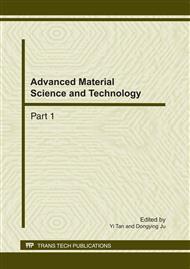p.361
p.365
p.369
p.375
p.379
p.383
p.387
p.391
p.395
Relationship between Mechanical Properties of Modified Cementitious Composites and Properties of Polymer Films
Abstract:
Keep the mixing amount of styrene-acrylic ester (SAE) constant, the mixtures of SAE and cellulose ethers (CE) were confected with tap water and filtered cement water respectively. The relationship between the mechanical properties of polymer modified cementitious composites (PMCCs) and the properties of polymer films was studied. It is discovered that when the cellulose ether-latex ratio (CE/L) increases, the polymer films become fragile. The properties of polymer films mutate when CE/L increases from 0.5‰ to 1.0‰. The tensile strength of the polymer films with filtered cement water is higher than that with tap water. However, the elongation at break is lower than that with tap water. The compressive strength of PMCCs decreases with the increase of the tensile strength of polymer films. Yet, the flexural strength of PMCCs does not relate to the properties of polymer films. The adhesive strength increases when CE/L increases from 0 to 1.0‰, but no longer after that.
Info:
Periodical:
Pages:
379-382
Citation:
Online since:
February 2011
Authors:
Price:
Сopyright:
© 2011 Trans Tech Publications Ltd. All Rights Reserved
Share:
Citation:


